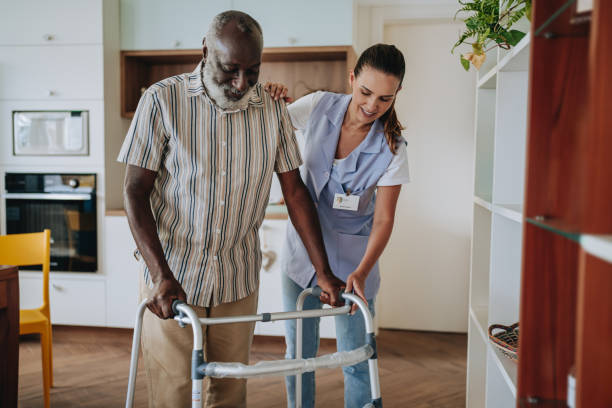Maintaining mobility, balance, and strength becomes increasingly important as people age. Seniors face a higher risk of falls and injuries due to muscle weakness, joint stiffness, and conditions like arthritis or osteoporosis. While hospital visits and rehabilitation centers provide excellent care, home-based physical therapy has emerged as a practical and effective way to prevent injuries in older adults. Physical therapy at home plays a crucial role in senior health and safety by focusing on targeted exercises, improving daily movements, and fostering independence.
Contents
- 1 Why Senior Injuries Are a Growing Concern
- 2 How Home-Based Physical Therapy Works
- 3 The Benefits of Physical Therapy at Home
- 4 Preventing Falls and Injuries with Home Therapy
- 5 Who Can Benefit from Home-Based Physical Therapy?
- 6 Making Physical Therapy at Home a Part of Daily Life
- 7 A Safer, Healthier Future for Seniors
Why Senior Injuries Are a Growing Concern
Injuries among seniors, especially falls, are a major public health issue. According to the Centers for Disease Control and Prevention (CDC), one in four Americans aged 65 and older falls each year, leading to fractures, hospitalizations, and even long-term disability. Many of these injuries could be prevented with proactive measures such as regular physical activity and balance training. However, some seniors struggle to attend rehabilitation centers due to mobility challenges, lack of transportation, or chronic health conditions. This is where home-based physical therapy proves invaluable.
How Home-Based Physical Therapy Works
Home physical therapy involves customized exercise programs designed to strengthen muscles, improve coordination, and increase flexibility. A licensed physical therapist assesses the individual’s physical condition, identifies areas of weakness, and develops a structured plan that fits their abilities and lifestyle. Unlike standard exercise routines, these programs are tailored to each senior’s specific needs, making them safer and more effective.
During home visits, physical therapists may guide seniors through exercises that target key areas such as:
- Balance and Coordination – Activities like standing on one foot, gentle yoga, or walking heel-to-toe help seniors maintain stability and prevent falls.
- Strength Training – Light resistance exercises using body weight, resistance bands, or household items improve muscle tone and reduce frailty.
- Flexibility and Mobility – Stretching routines and range-of-motion exercises enhance joint function and decrease stiffness.
- Posture and Gait Training – Therapists work on correcting posture and walking techniques to prevent missteps that lead to injuries.
Home-based physical therapy reduces the risk of falls and enhances overall movement by focusing on these areas, allowing seniors to remain active and independent.
The Benefits of Physical Therapy at Home

One key advantage of home-based therapy is that it eliminates the need for seniors to travel to a clinic. This is particularly beneficial for those with mobility limitations, chronic pain, or transportation difficulties. Additionally, therapy in a familiar home environment allows seniors to practice movements relevant to their daily activities.
- Increased Comfort and Convenience
Receiving therapy at home ensures a relaxed setting where seniors feel more at ease. They can engage in exercises without the stress of unfamiliar surroundings or travel-related fatigue. - Personalized Care
Since therapists work one-on-one with patients at home, they can provide individualized attention. This results in a more personalized exercise plan that addresses each senior’s unique challenges and goals. - Greater Safety
Practicing exercises at home allows therapists to identify potential hazards such as loose rugs, poor lighting, or furniture that could cause tripping. They can recommend modifications to create a safer living space. - Increased Compliance and Motivation
Many seniors struggle to stick to an exercise routine on their own. Therapists provide motivation and accountability through home visits, helping seniors stay committed to their health and well-being. - Faster Recovery and Improved Quality of Life
Home-based therapy accelerates healing for seniors recovering from injuries, surgery, or a long period of inactivity. By restoring strength and mobility, seniors can regain their independence and continue enjoying their daily activities.
Preventing Falls and Injuries with Home Therapy
A major focus of physical therapy for seniors is fall prevention. Falls often result in serious injuries such as hip fractures or head trauma, leading to lengthy hospital stays and decreased quality of life. Home therapy addresses this by strengthening muscles, improving reflexes, and teaching seniors how to move safely.
Therapists also educate seniors on how to get up safely after a fall and provide guidance on using mobility aids like canes or walkers correctly. Additionally, they assess home environments and suggest modifications, such as installing grab bars in bathrooms, using non-slip mats, and rearranging furniture to allow for easier movement.
Who Can Benefit from Home-Based Physical Therapy?
Any senior experiencing mobility issues, muscle weakness, or balance problems can benefit from home therapy. It is particularly helpful for those who:
- Have you had a recent fall or near-fall incident
- Are you recovering from surgery or injury
- Suffer from conditions like arthritis, osteoporosis, or Parkinson’s disease
- Experience dizziness, poor coordination, or muscle stiffness
- Feel unsteady while walking or standing
Even seniors who are generally healthy can benefit from therapy sessions to maintain strength and prevent future mobility issues.
Making Physical Therapy at Home a Part of Daily Life
Consistency is key in physical therapy. Seniors should aim to integrate recommended exercises into their daily routine. Therapists often provide guidelines for safe movements that seniors can practice independently between sessions. Family members and caregivers can also play a role by encouraging participation and assisting with exercises when needed.
Additionally, simple lifestyle changes can complement therapy efforts. Activities like stretching in the morning, using sturdy footwear, and staying active with hobbies such as gardening or dancing contribute to maintaining mobility.
A Safer, Healthier Future for Seniors
Physical therapy at home is a practical and effective way to prevent senior injuries, improve mobility, and enhance overall well-being. By addressing balance, strength, and flexibility, seniors can reduce their risk of falls and maintain independence for longer with professional guidance and a commitment to staying active, aging adults can enjoy a safer and healthier future.

